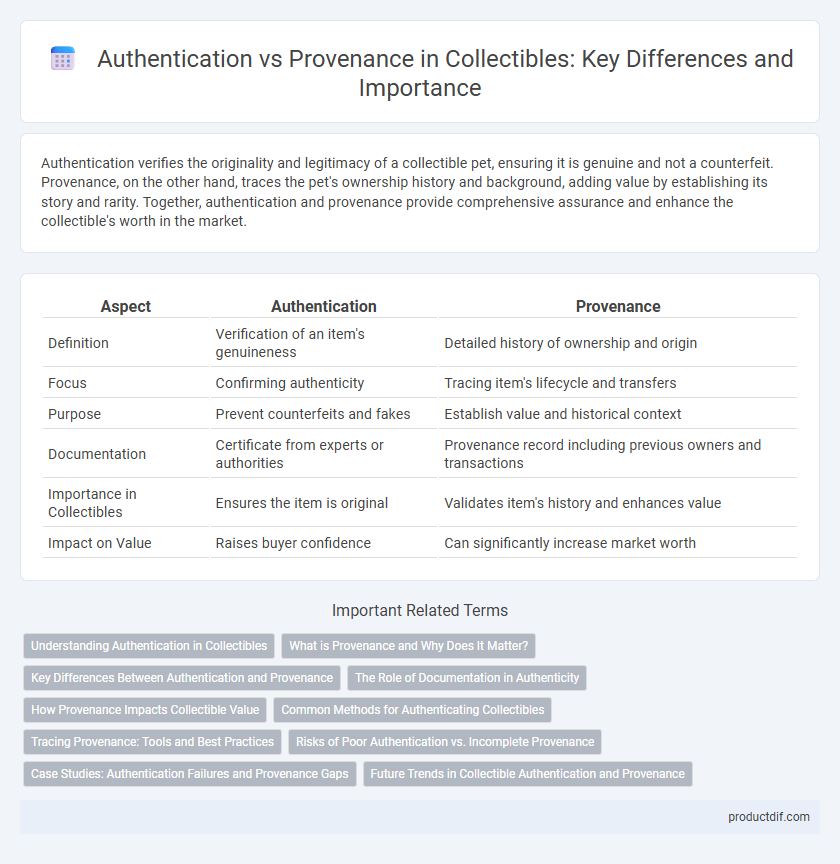Authentication verifies the originality and legitimacy of a collectible pet, ensuring it is genuine and not a counterfeit. Provenance, on the other hand, traces the pet's ownership history and background, adding value by establishing its story and rarity. Together, authentication and provenance provide comprehensive assurance and enhance the collectible's worth in the market.
Table of Comparison
| Aspect | Authentication | Provenance |
|---|---|---|
| Definition | Verification of an item's genuineness | Detailed history of ownership and origin |
| Focus | Confirming authenticity | Tracing item's lifecycle and transfers |
| Purpose | Prevent counterfeits and fakes | Establish value and historical context |
| Documentation | Certificate from experts or authorities | Provenance record including previous owners and transactions |
| Importance in Collectibles | Ensures the item is original | Validates item's history and enhances value |
| Impact on Value | Raises buyer confidence | Can significantly increase market worth |
Understanding Authentication in Collectibles
Authentication in collectibles involves verifying an item's originality and confirming it is genuine, typically through expert evaluation or scientific analysis. This process helps establish trust and value by ensuring the collectible is not a counterfeit or reproduction. Provenance complements authentication by documenting the item's ownership history, but authentication remains the critical step to confirm authenticity.
What is Provenance and Why Does It Matter?
Provenance refers to the documented history of a collectible item, detailing its origin, ownership, and transfer over time, which establishes its authenticity and value. Unlike authentication, which verifies the item's genuineness at a specific point, provenance provides a comprehensive chain of custody that enhances trust and market confidence. Provenance impacts collectible valuations by reducing the risk of forgeries and ensuring historical significance, making it a critical factor for collectors and investors.
Key Differences Between Authentication and Provenance
Authentication verifies the legitimacy of a collectible through expert analysis, examining factors such as materials, craftsmanship, and signatures to confirm its originality. Provenance traces the ownership history and origin of the collectible, providing a documented chain that establishes its historical context and legitimacy. Key differences lie in authentication confirming authenticity, while provenance documents the collectible's background and ownership lineage.
The Role of Documentation in Authenticity
Documentation plays a critical role in establishing the authenticity of collectibles by providing verifiable evidence of origin and ownership history. Authenticity is often confirmed through certificates issued by recognized experts, detailed appraisals, and receipts that trace the item's journey from manufacturer or artist to current holder. Provenance complements this by offering a documented chain of custody, reinforcing the collectible's legitimacy and market value through transparent historical records.
How Provenance Impacts Collectible Value
Provenance directly influences collectible value by providing a verified history of ownership, enhancing authenticity and trust among buyers. Detailed provenance establishes an object's legitimacy, reducing the risk of forgery and increasing market demand. Collectors prioritize items with documented provenance as it often leads to higher appraisal values and better resale potential.
Common Methods for Authenticating Collectibles
Common methods for authenticating collectibles include expert appraisal, certification from reputable organizations, and detailed documentation such as certificates of authenticity. Technological tools like ultraviolet light inspection, magnification, and digital barcode verification enhance accuracy by revealing hidden markers or verifying serial numbers. Provenance, referring to the item's ownership history, complements authentication by tracing its origin but does not replace scientific or expert validation techniques.
Tracing Provenance: Tools and Best Practices
Tracing provenance in collectibles involves detailed documentation that verifies an item's history, ownership, and authenticity, enhancing its value and credibility. Key tools include blockchain technology, digital certificates, and expert appraisals, which ensure transparent and tamper-proof records. Best practices recommend maintaining thorough provenance records from the point of acquisition, employing third-party verification services, and integrating advanced tracking systems to prevent fraud.
Risks of Poor Authentication vs. Incomplete Provenance
Poor authentication exposes collectors to counterfeit risks, diminishing the collectible's value and market credibility. Incomplete provenance limits an item's historical documentation, raising doubts about its legitimacy and ownership history. Both issues compromise buyer confidence and can lead to significant financial losses in the collectibles market.
Case Studies: Authentication Failures and Provenance Gaps
Authentication failures in collectibles often result from forged certificates or counterfeit markings, leading to significant financial losses and diminished trust in the market. Provenance gaps, where the ownership history is incomplete or unverifiable, create challenges in establishing an item's legitimacy and can cause legal disputes or devaluation. Case studies highlight instances such as the disputed origins of rare stamps and misattributed artworks, underscoring the critical need for rigorous verification processes combining both authentication and provenance documentation.
Future Trends in Collectible Authentication and Provenance
Future trends in collectible authentication and provenance emphasize blockchain technology to enhance transparency and reduce fraud. Advanced AI-driven image recognition and forensic analysis improve the accuracy of verifying items' origins and authenticity. Integration of decentralized digital ledgers ensures immutable provenance records, boosting collector confidence and market value.
authentication vs provenance Infographic

 productdif.com
productdif.com